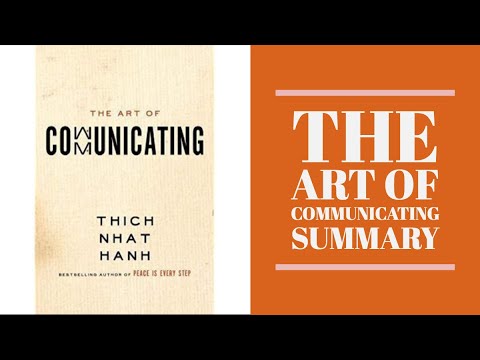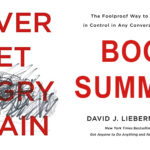
The Art of Communicating by Thich Nhat Hanh (Summary)
Note: Thanks Priyanka Athma Shakti Scarlet for the recommendation. :)
When we say something that nourishes us and uplifts the people around us, we are feeding love and compassion. When we speak and act in a way that causes tension and anger, we are nourishing violence and suffering.
What you read and write can help you heal, so be thoughtful about what you consume.
You have to protect yourself with the energy of compassion so that when you listen, instead of consuming toxins, you’re actively producing more compassion in yourself. When you listen in this way, compassion protects you and the other person suffers less.
Love, respect, and friendship all need food to survive. With mindfulness we can produce thoughts, speech, and actions that will feed our relationships and help them grow and thrive.
If our minds are blocked, there is no device that will make up for our inability to communicate with ourselves or others.
If our minds are blocked, there is no device that will make up for our inability to communicate with ourselves or others. With our in-breath and our out-breath, our mindful breathing, we begin to tidy up our homes. When you breathe in, you come back to yourself. When you breathe out, you release any tension.
Our suffering has been trying to communicate with us, to let us know it is there, but we have spent a lot of time and energy ignoring it. These feelings are like a small child tugging at our sleeves. Pick them up and hold them tenderly.
If we are able to understand that suffering and thereby transform it, we are healing our parents and our ancestors as well as ourselves. Any suffering that has not been released and reconciled will continue.
Don’t neglect to reserve some time alone each day for communicating with
yourself.
2 keys to effective and true communication.
– The first is deep listening.
– The second is loving speech.
I am listening to this person with only one purpose: to give this person a chance to suffer less.
Listening to suffering is an essential ingredient for generating understanding and love.
The question “Do you think I understand you enough?” is not just for romantic relationships, but for friends, family members, and anyone you care about.
4 Elements of Right Speech
– Tell the truth. Don’t lie or turn the truth upside down.
– Don’t exaggerate.
– Be consistent. This means no double-talk: speaking about something in one way to one person and in an opposite way to another for selfish or manipulative reasons.
– Use peaceful language. Don’t use insulting or violent words, cruel speech, verbal abuse, or condemnation.
4 Criteria
– We have to speak the language of the world.
– We may speak differently to different people, in a way that reflects how they think and their ability to receive the teaching.
– We give the right teaching according to person, time, and place, just as a doctor prescribes the right medicine.
– We teach in a way that reflects the absolute truth.
6 Mantras of Loving Speech (Practice mindful breathing before saying them)
– I am here for you.
– I know you are there, and I am very happy.
– I know you suffer, and that is why I am here for you.
– I suffer, please help. (I suffer, and I want you to know it. I am doing my best. Please help.)
– This is a happy moment. (It is possible to be happy right here and right now.)
– You are partly right. (When someone praises or criticizes you.)
Suppressing anger can be dangerous. It will explode if it is ignored. Anger, like all strong emotions, wants to express itself. So how do we handle it? The best thing is to go home to ourselves and take care of our anger. We can remember the first mantra and be there for ourselves and take care of our anger. We return to ourselves and connect body and mind. Return to your practice of mindful breathing and mindful walking. To be present means to be mindful and then use that mindfulness to recognize, embrace, and look deeply at our strong emotions.
If you communicate well in your work environment, not only do you enjoy yourself more, but you create a harmonious atmosphere that will carry over into your work. Everything you do will have a stronger element of compassion and be of greater benefit to more people.
Scientists have studied the behaviour of social animals, such as birds and fish, and have found that in every community there is an element of altruism; some members of the community are ready to die and sacrifice their lives for the sake of the community. According to scientists who have conducted studies, when you’re exposed to such behaviour from some members of your community, the seed of altruism in you is watered. And when your turn comes, you will do the same—you will know how to sacrifice for the sake of the community.
Take time to go back and tenderly embrace the wounded child within you.
You can talk to the child with the language of love. “Dear one, in the past,
I left you alone. I’ve gone away from you for so long. I’m sorry. Now I
have come back to take care of you, to embrace you. I know you suffer so
much, and I have neglected you. But now I’ve learned the way to take care
of you. I am here now.” (See Self-Parenting for more exercises)
You may practice hugging meditation with a friend, your daughter, your father, your partner, or even with a tree. To practice, first bow and recognize the presence of the other. Close your eyes, take a deep breath, and visualize yourself and your beloved three hundred years from now. Then you can enjoy three deep, conscious breaths to bring yourself fully there. You can say to yourself: “Breathing in, I know that life is precious in this moment. Breathing out, I cherish this moment of life.”
You can also practice it in the following way: During the first in-breath and out-breath, become aware that you and your beloved are both alive. For the second in-breath and out-breath, think of where you will both be three hundred years from now. And for the third in-breath and out-breath, go back to the insight that you are both alive.
Amazon #ads
Contents
1 Essential Food
Consuming with Mindfulness
Relationships Don’t Survive Without the Right Food
2 Communicating with Yourself
Connecting Internally
Digital Purpose
Coming Home
Communicating with the Breath
Nonthinking and Nontalking
Come Back
Communicating with the Body
Take Yourself for a Walk
Walking on the Earth Heals Our Alienation
Connecting to Our Suffering
The Suffering of Our Ancestors
Listening Deeply
Suffering Brings Happiness
Understanding Our Own Suffering Helps Us Understand Others
Loving Yourself Is the Basis for Compassion
3 The Keys to Communicating with Others
Saying Hello
The Two Keys to Compassionate Communication
Now Is the Time to Listen Only
Love Is Born from Understanding
Do I Understand You Enough?
Loving Speech
Wrong Speech
The Four Elements of Right Speech
The Four Criteria
Help People Understand
Using Right Speech in Daily Life
4 The Six Mantras of Loving Speech
Bringing Compassionate Communication to Your Relationships
5 When Difficulties Arise
Communicating When You’re Angry
Helping Each Other Suffer Less
The Suffering of Pride
Reconciling in Families
Communicating in Long-Term Relationships
Mutual Understanding in Challenging Situations
Peace Negotiations
6 Mindful Communication at Work
Leading by Example
Greeting Your Colleagues
Answering the Phone
Mindful Meetings
Creating Community at Work
A Rock in the River
7 Creating Community in the World
Community Creates Change
Building Trust and Sharing Suffering
Community Strengthens Compassion
Our World Can Be a Mindful, Compassionate Community
8 Our Communication Is Our Continuation
Every Communication Bears Our Signature
Changing the Past
9 Practices for Compassionate Communication
The Computer Bell
Drinking Tea in Mindfulness
Listening to Your Inner Child
Writing a Love Letter
Peace Treaties and Peace Notes
Beginning Anew
The Cake in the Refrigerator
Hugging Meditation
About the Author
Also by Thich Nhat Hanh
Copyright
About the Publisher





